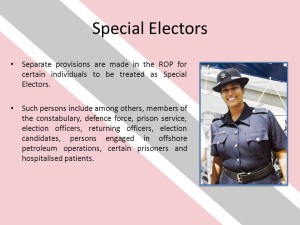Voting by Special Ballot for Canadian Forces Electors
Voting by Special Ballot for Canadian Forces Electors
 During federal elections and referendums, Canadian Forces electors can vote, by mail or at polling stations set up in their units, using a special ballot. This method of voting is governed by the Special Voting Rules, Part 11 of the Canada Elections Act. Canadian Forces electors who are residing in the electoral district of the address shown on their Statement of Ordinary Residence at the time of a general election may also vote at a civilian polling station in that electoral district, provided they have not already voted by special ballot.
During federal elections and referendums, Canadian Forces electors can vote, by mail or at polling stations set up in their units, using a special ballot. This method of voting is governed by the Special Voting Rules, Part 11 of the Canada Elections Act. Canadian Forces electors who are residing in the electoral district of the address shown on their Statement of Ordinary Residence at the time of a general election may also vote at a civilian polling station in that electoral district, provided they have not already voted by special ballot.
Canadian Forces electors are Canadians who have reached the age of 18 and are members of the Canadian Forces or teachers or administrative support staff in Canadian Forces schools outside Canada.
People living with members of the Canadian Forces outside the country are not considered to be Canadian Forces electors, but may vote as Canadians residing outside Canada (see Backgrounder EC 90540, Voting by Special Ballot).
Registration
The Department of National Defence keeps a permanent register of Canadian Forces electors. When they enroll, each CF member completes a Statement of Ordinary Residence (SOR) that determines the electoral district for which his or her vote will be counted.
Manner of voting
Canadian Forces electors vote by special ballot. During a general election or referendum, instructions for voting are posted at the polling station in each unit and a deputy returning officer is on hand to issue voting materials. Each polling station has a complete list of candidates. During by-elections, Elections Canada sends a personalized voting kit to every elector whose address on the Statement of Ordinary Residence is located in a riding where a by-election is being held.
To vote, the elector must first complete and sign the declaration on the outer envelope that forms part of the voting kit. The declaration states that his or her name is as shown on the envelope and that he or she has not already voted in the election or referendum underway. The elector then completes the ballot by writing on it the name of one of the candidates in his or her riding – or, in the case of a referendum, by checking either “yes” or “no” – and then inserting the ballot in the series of envelopes in accordance with the instructions provided.
Finally, the elector is responsible for ensuring that Elections Canada in Ottawa receives the ballot no later than 6:00 p.m., Eastern Time, on polling day. Electors may mail their ballots themselves or, in most cases, during a general election or referendum, leave them with the deputy returning officer to forward by special arrangement. The ballot must be sent in the envelopes provided. A ballot received by any other means, including fax, will not be counted. The Act also prohibits counting ballots received after the deadline.
Counting the votes
The ballots of Canadian Forces electors are counted at the same time as those of Canadian residents absent from their ridings, electors residing outside Canada and incarcerated electors, provided they have been received at Elections Canada in Ottawa before 6:00 p.m., Eastern Time, on polling day. The procedure is described below.
